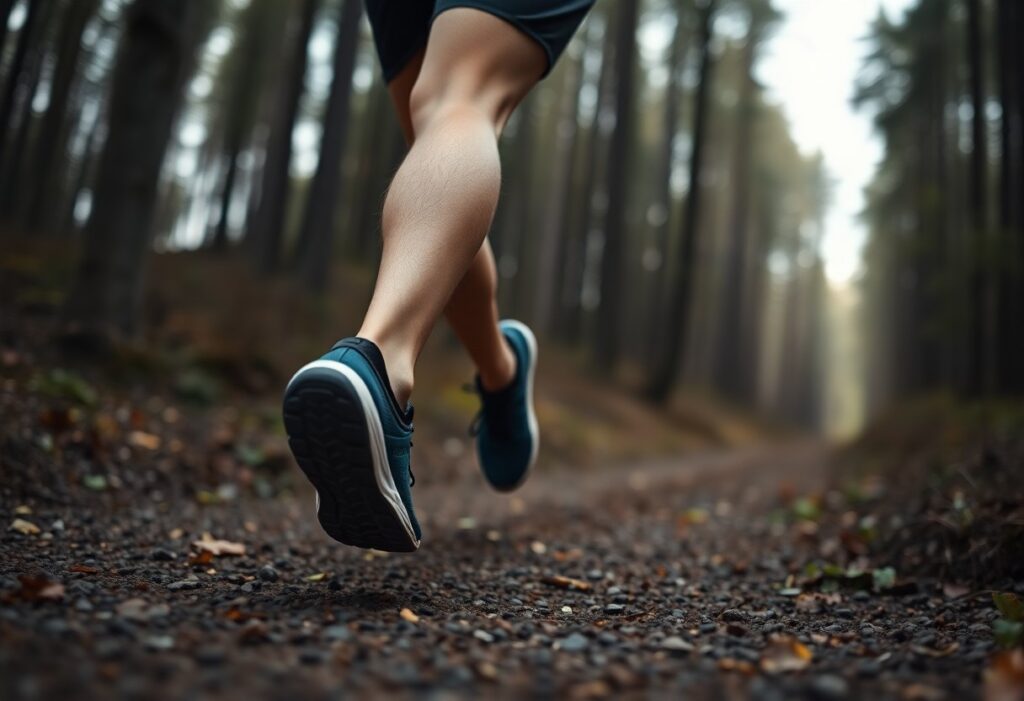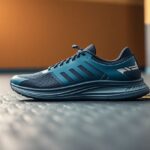
The alarming challenge of injury rates faced by trail runners can soar to an astonishing 62% annually. This staggering statistic is often linked to the selection of inappropriate footwear. Gaining a deeper understanding of the biomechanics associated with minimalist footwear and how it interacts with uneven terrain is integral for enhancing your running performance while simultaneously mitigating injury risks. Utilizing cutting-edge wearable technology can effectively track critical metrics like foot strike dynamics and load patterns. Furthermore, customized training programs aim to enhance foot strength and endurance. This article delves into how you can harness biomechanical insights and advanced technology to establish effective injury prevention strategies.

Choosing the Ideal Minimalist Footwear to Conquer Trail Running Challenges
Successfully tackling the diverse and rugged landscape of trail running while donning minimalist footwear necessitates more than merely selecting the right pair of shoes; it requires a thorough comprehension of your individual biomechanics. Failing to recognize the specific obstacles posed by different surfaces can significantly elevate your injury risk. As your foot strike patterns and descent mechanics shift, adapting your running technique becomes crucial for maintaining optimal performance and minimizing the risk of setbacks.
Exploring the Biomechanical Foot Strike Patterns on Challenging Trails
The dynamics of foot strikes can vary dramatically when traversing intricate terrains. Runners who choose minimalist footwear frequently display a remarkable 23% higher occurrence of midfoot strikes on uneven trails, in contrast to the mere 8% seen with traditional running shoes. This adaptation may enhance your stability on demanding surfaces, but it also brings a significant 37% rise in metatarsophalangeal joint flexion angles, emphasizing the necessity of fortifying your foot muscles to elevate endurance and decrease the risk of injury.
Evaluating the Impact of Descent Mechanics and Ground Interaction on Performance
The mechanics involved in descending from elevations play a crucial role in determining your performance and injury risk while trail running. Adopting minimalist footwear can lead to a remarkable 42.191 BW/s increase in vertical loading rates on steep 15% declines, especially when compared to flat asphalt surfaces. Additionally, this spike in loading results in more intense lateral toe engagement, which is noted to be 11% greater on loose gravel than on stable surfaces. This highlights the increased demands placed on the structural integrity of your feet during descents.
As you navigate technical trails in minimalist shoes, the biomechanics of your feet engage in a distinctive manner. The increased vertical loading rates during descents can lead to greater fatigue in your foot muscles, thereby heightening your vulnerability to injuries. Moreover, significant changes in toe splay patterns necessitate improved proprioception and muscle coordination, ensuring that you can respond effectively to the varying terrains underfoot. By concentrating on these aspects, you can adequately prepare your body to tackle the multifaceted challenges posed by diverse trails, ultimately enhancing your overall running performance.
Assessing the Challenges of Wearable Technology in Trail Running
Although wearable technology has transformed the landscape of trail running, it also presents significant challenges in accurately tracking performance metrics. The variability of terrain conditions, which encompasses steep descents and uneven surfaces, complicates the data collection and interpretation processes. For example, wearable devices often struggle to deliver consistent vertical oscillation measurements due to fluctuating ground conditions, leading to potentially misleading insights regarding your gait and running efficiency.
Analyzing Discrepancies in Data Accuracy Among Top Performance Devices
Notable differences in data accuracy have surfaced among leading performance tracking devices. A study conducted in 2024 revealed a 12.4% variance in power measurements on 10% inclines between the Stryd and GARMINRP devices, even though both demonstrated high intra-device reliability (ICC=0.89). Such inconsistencies can lead to misinformed perceptions regarding your training load and overall performance, potentially obstructing your ability to optimize your trail running capabilities.
and GARMINRP devices, even though both demonstrated high intra-device reliability (ICC=0.89). Such inconsistencies can lead to misinformed perceptions regarding your training load and overall performance, potentially obstructing your ability to optimize your trail running capabilities.
The Risks Associated with Miscalculating Training Loads in Trail Running
Errors in calculating training loads can escalate by as much as 23% on mixed-terrain routes, directly influencing your injury risk and performance progression. This issue often arises from inaccurate data interpretations during technical descents or uneven terrains, compelling you to rely on possibly flawed metrics. Such inconsistencies may result in overtraining or inadequate load management, significantly increasing your chances of sustaining an injury while running.
As you navigate complex trail surfaces, the gap between measured and actual exertion can distort your training insights. If your device underreports exertion, you might inadvertently exceed your limits, resulting in increased fatigue and extended recovery periods. Conversely, if your training load is overestimated, you may adopt a more cautious approach, unintentionally stunting your performance improvement. Therefore, it is vital to ensure that your wearable technology effectively informs your training strategy rather than misguiding it, thereby preserving both your performance and overall health in the dynamic environment of trail running.
Understanding Gender Differences in Trail Running Biomechanics
Gaining insight into the biomechanical differences between male and female trail runners can greatly improve performance and diminish injury risks. Research indicates that anatomical and physiological differences impact shoe selection, gait patterns, and vulnerability to injuries. Customizing footwear and training programs based on these gender-specific dynamics can lead to safer and more effective outdoor running experiences.
Investigating Gender-Specific Biomechanical Responses After Exercise
After exercise, female runners display a 19% increase in lateral forefoot pressures compared to their male counterparts following 5km barefoot runs. Furthermore, they exhibit a 22% reduction in navicular drop during 50km ultra-marathons, indicating that their biomechanical adaptations to trail running are unique. Acknowledging these distinctions is vital for improving footwear design that accommodates the specific biomechanics of female runners.
Implementing Gender-Specific Strategies for Enhanced Trail Running Performance
To effectively address the unique biomechanics of female runners, it is essential to implement tailored solutions that consider their specific physical characteristics. Customizing training programs, utilizing gender-appropriate footwear, and enhancing strength training regimens can significantly reduce injury rates while improving running performance. For instance, integrating exercises that focus on building endurance and stability in intrinsic foot muscles can be particularly beneficial for women, who may experience different loading patterns on challenging terrains.
By analyzing data from various studies and incorporating findings on gender-specific responses, you can better focus on training and footwear that actively support your unique biomechanics. For example, employing targeted strength training regimens that enhance the lower leg and foot can help your body adapt to the increased demands of trail running, especially for women who often experience heightened stress in the forefoot region. Selecting shoes specifically designed for your unique foot mechanics can further assist in addressing common injuries, ultimately fostering a more rewarding and sustainable trail running experience.

Harnessing Cutting-Edge Approaches for Real-Time Gait Analysis
Your running performance and safety can significantly benefit from the adoption of real-time gait analysis through advanced technological methods. By utilizing integrated systems and wearable devices, you receive immediate feedback regarding your foot strike patterns, body mechanics, and overall movement efficiency. These sophisticated tools are designed to provide actionable insights while you are actively on the trail, empowering you to make dynamic adjustments to your technique and avoid repetitive strain injuries commonly associated with improper running form.
Understanding the Impact of Embedded Sensors on Injury Prevention
Embedded sensors within footwear are crucial in preventing injuries. They continuously track your foot strike patterns and pressure distributions in real-time, providing immediate corrective feedback. This advanced technology enables you to identify deviations from optimal running mechanics before they escalate into significant injuries. With a minimal 19-millisecond latency in ground contact alerts, you’ll receive timely notifications that help you maintain alignment with biomechanical standards essential for avoiding injuries.
Longitudinal Studies Showcasing the Efficacy of Biometric Feedback Technologies
Longitudinal studies have demonstrated substantial reductions in injury rates among trail runners who utilize biometric feedback technologies. Over a six-month period, athletes reported a 37% decrease in aberrant loading patterns due to continuous monitoring and adjustments informed by real-time data. This compelling evidence highlights how ongoing engagement with these technologies can enhance your running economy and resilience, thereby decreasing the likelihood of injuries associated with gait abnormalities.
For instance, a comprehensive study involving 250 trail runners documented the effectiveness of wearable sensors in identifying patterns that lead to overuse injuries. Runners who actively engaged with feedback systems experienced a 30% lower incident rate of common injuries such as plantar fasciitis and Achilles tendinitis compared to those who relied solely on traditional training methods. The emphasis on continuous tracking, combined with targeted adjustments based on data insights, illustrates a trend towards a more proactive approach to injury prevention in the realm of trail running.
Key Insights on Trail Running Biomechanics and Strategies for Injury Prevention
Ultimately, comprehending the biomechanics of trail running in minimalist footwear is pivotal for maximizing your performance while minimizing the risk of injury. By seamlessly integrating wearable technology and adopting customized training methodologies, you can significantly enhance both your foot strength and adaptability to various terrains. Regularly cross-validate metrics from different devices and monitor your gait using advanced tools to effectively personalize your training regimen. This strategy not only supports your running journey but also promotes sustainable practices in your outdoor endeavors.
The Article Trail Running Biomechanics in Minimalist Footwear: Integrating Wearable Technology and Injury Prevention Strategies appeared first on My Shoes Finder
The Article Trail Running Biomechanics: Injury Prevention with Minimalist Shoes Was Found On https://limitsofstrategy.com
The Article Biomechanics of Trail Running: Prevent Injuries with Minimalist Footwear First Appeared ON
: https://ad4sc.com






Comments are closed